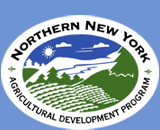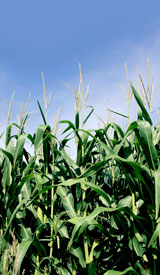

Northern New York Agricultural Development Program Press
Releases
August 6, 2006
Contact: Jerry H. Cherney, Cornell
University, 607-255-0945
Peter Barney, Cornell Cooperative Extension of St. Lawrence County,
315-379-9192
Jon Greenwood, Greenwood Dairy, 315-386-3231
A New Way to Make Hay in Northern New York?
By some estimates, as much as 25 percent of a hay crop can be lost to
inclement weather. So, speeding up the process for making haylage �
finely cut hay stored in silos or feedbunks - while improving the
quality of the cut forage equals time saved, a better dairy feed, and
increased milk production.
With funding from the Northern New York Agricultural Development
Program, farmers Cornell University researchers and Cornell Cooperative
Extension educators have begun evaluating wide-swath mowing and hay
conditioning as a speedier way for North Country farmers to cut, harvest
and store haylage all in one day.
Wide swath mowing spreads cut forage to 90 percent or more of the cut
width, creating up to three times more sun exposure over
traditionally-harvested narrow windrows. Conditioning forces the
moisture out of cut stems and leaves and may speed drying time by as
much as 30 percent in some areas.
Project leader Cornell University Crop and Soil Science Professor and
NYS Forage Specialist Dr. Jerry H. Cherney says, �While conditioning
clearly helps make baled dry hay, it is not clear that conditioning,
with either rollers or finger-type conditioners, provides significant
help during the drying down process to harvest haylage. Conditioning
requires increased power output with added fuel costs, so if that step
can be eliminated, farmers save.�
Cornell University Animal Science Associate Professor Debbie J. R.
Cherney says same-day wide swath harvesting allows the hay to continue
to photosynthesize after cutting and avoids overnight loss of sugars in
the forage. A higher sugar content makes a higher quality forage for
dairy cows and milk production.
Wide swathing offers a gain of 300 lbs. worth of potential milk
production in every ton of dry matter fed as silage and a nine or more
percent increase in milk production, says Thomas F. Kilcer of Cornell
Cooperative Extension of Rensselaer County. Kilcer, credited with
initiating research into the benefits of wide swathing for making an
on�farm feed source more easily digested by cows, says, �The value of
wide swath harvesting to farmers is more than $40 per ton of dry matter
fed as silage.�
Extension educators harvested first-cut haylage with a nine-foot wide
swath disc mower on the St. Lawrence County dairy farms of Bernie
Moulton and Jon Greenwood. They also cut narrow swaths with a mower and
finger-type conditioner, used a mower-conditioner fitted with a wide
swath kit mounted behind the conditioner, and used a mower-conditioner
to cut a narrow swath that was immediately tedded out to 100 percent of
cut width. For comparison, haylage was also harvested from narrow
windrows that were left to dry overnight.
Analysis of wide and narrow cut haylage samples harvested on the St.
Lawrence County dairy farms of Bernie Moulton and Jon Greenwood is
underway at Cornell labs. The extremely dry days on which the hay was
cut may skew the first year data.
�Our quality analysis is not yet complete, but we expect, because of the
unusually fast drying times, that all treatments, both narrow and wide
swath will ensile well. Scientifically, however, we need to reserve
judgment until more data can be obtained for comparative evaluation
under different cutting and climate conditions,� Cherney says.
Dairymen Jon Greenwood of Greenwood Dairy, Canton, and Bernie Moulton of
Paradise Valley Farm, Madrid, say the project is a good start toward
learning if the haylage harvesting technique of wide swath mowing
without conditioning will help North Country farmers.
Greenwood says, �Same day harvesting gives us an advantage over the next
day�s weather. The project results should help us answer the questions
of how important is conditioning or is it necessary. Whatever practice
we use needs to produce a high quality forage and easily marry the
research data with on-farm practicality.�
Moulton, who also custom harvests hay, says, �If we learn that we can
cut better quality forages to feed and buy less grain, we will save on
feed costs. I am looking forward to the results of the quality analysis
and to find out how much grass we can expect to mow in the morning and
have harvested by night in one day.�
Cornell Cooperative Extension of St. Lawrence County Field Crops
Educator Peter Barney says, �Dairy farmers looking to improve their
profitability by feeding high quality forage are interested in the
results of this project. If a farmer can harvest quality feed the same
day, eliminating the variables that Mother Nature brings in the weather
and the plant�s exposure overnight, wide swathing will be a good thing.
We need to wait for Dr. Cherney�s final report on how well wide swathing
captures quality and if the quality gain makes the wide-swathing system,
the labor commitment and the possible purchase of new equipment
profitable.�
Barney says farmers who bale dry hay are calling to ask if wide swathing
might also speed the process for producing early-cut baled hay to feed
on the farm and to sell.
A final report on the wide-swath haylage project in Northern New York is
expected later this year. The Northern New York Agricultural Development
Program funds research and education outreach for Essex, Clinton,
Franklin, St. Lawrence, Lewis and Jefferson counties. For more
information, go online to www.nnyagdev.org. # # #
Tom Kilcer�s Silage Swath Management for
Maximum Quality
Fact Sheet
http://counties.cce.cornell.edu/rensselaer/Agriculture/alfalfa_research.htm
